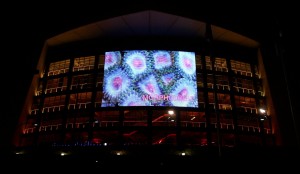
Coral, Coral On the Walls
Did you know that almost every concrete structure in Miami includes locally mined, ground up fossilized coral and marine limestone? Such an integral element has gone unrecognized for far too long,
according to a marine biologist and a musician, who double as video artists.
Starting next week during Art Basel Miami Beach, the duo who call themselves Coral Morphologic will project large-scale videos of hyper-realistic coral reef organisms on Miami Beach buildings, in what they have titled “Artificial Reef.”
It’s one of the most inventive concepts taking place, thanks to a grant from the Knight Foundation, and will be one of the most eye-catching as well — quite a feat for such a week. So we asked biologist Colin Foord about it.
Tell us about the history of this collaboration?
“Jared [McKay] and I formed Coral Morphologic three years ago, after I convinced him to move to Miami to start a coral aquaculture company, with with the eventual goal of building a multimedia aquarium art studio. Little by little, and very organically, I think that we have successfully achieved this goal, having just recently moved our facility out of our house and into a proper warehouse in Overtown. He and I are best friends from middle school, and we know and trust each other well enough that we can think very efficiently and creatively together.
What is its relationship to Miami?
“Miami is a colorful, neon city. It is warm, nearly tropical, and full of life. It shares many of the same attributes that make coral reef ecosystems so beautiful and interesting. And beyond the metaphorical similarities, Miami’s concrete infrastructure owes itself to the region’s limestone bedrock that was produced by coral reef organisms thousands of years ago when South Florida was under water and the sea level was much higher.
“In fact, the only thing that seems to be constant for South Florida’s dry land has been repeated submersion.”
What about the relationship between science and art?
“In order to understand how all these things are inter-related and to present them as art, it really takes a good grasp of science. As a marine biology student, I realized that while it might be impressive to become an expert on some obscure group of organisms, it would be very easy to become ‘lost in the microscope,’ and lose the ability to auto-focus and put everything else into perspective. I decided that if I was going to study something, I wanted to be able to put it into a more universal context that could be related by and useful to many different types of people.
“This is when I started to see art and science intersect. Art is about abstraction, whereas science is about objectivity. With ‘Artificial Reef’ we are presenting very objective documentation of living creatures, but presenting it in an abstract form that causes some deeper thinking about why these corals are pulsing on buildings.
“The titles of each of the public projections Cassiopeia, Helios and Clytie are all references to Greek mythology. Myths are based on archetypes, and corals are archetypal organisms. Throughout history, mankind has identified certain animals with archetypal, humanistic traits for their myths. … Corals on the other hand, are only recently being understood. Coral Morphologic is in the very rare and privileged position to identify and create a new mythology.
“And in any good myth, there needs to be a takeaway message that inspires better informed decisions in life. We felt it would be fitting to reference the classical mythology to introduce these three animals to the public. There is great significance behind each of the titles as it applies to the projections.”
“Artificial Reef” takes place from Dec. 2 to Dec. 5, 6:00 p.m. to 1:00 a.m., with opening reception on Dec. 3 at 7:00 p.m., Art Deco Welcome Ctr., 1001 Ocean Drive.
Cassiopeia will be projected on the 407 Building, 407 Lincoln Rd., Clytie projected on the Art Deco Welcome Center.; and Helios on the Wolfsonian Museum, 1001 Washington Ave. www.morphologicstudios.com.
Recent Content
-
Artsarticle ·
-
Artsarticle ·
-
Artsarticle ·

